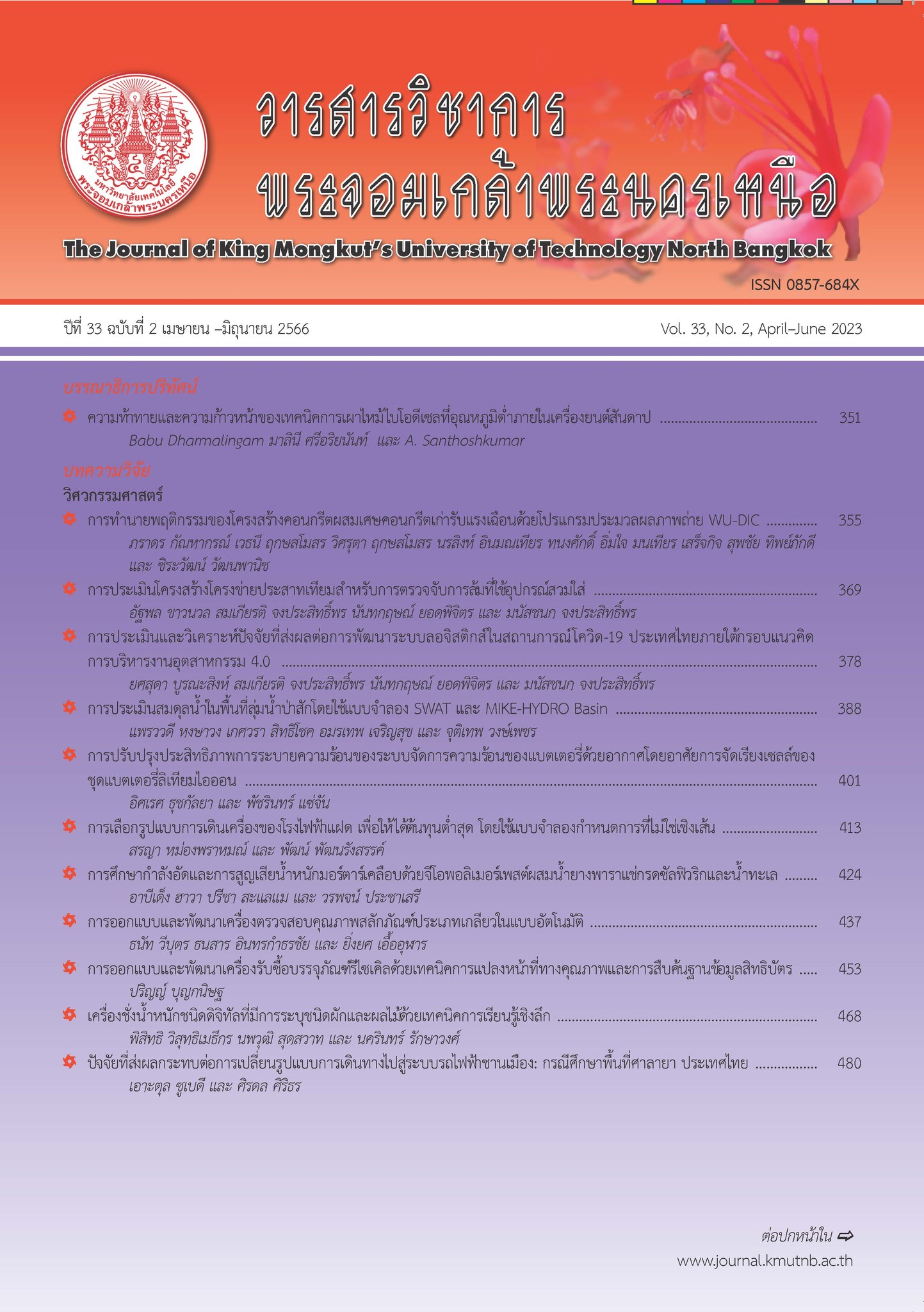การทำนายพฤติกรรมของโครงสร้างคอนกรีตผสมเศษคอนกรีตเก่ารับแรงเฉือนด้วยโปรแกรมประมวลผลภาพถ่าย WU-DIC
Main Article Content
บทคัดย่อ
การรื้อถอนโครงสร้างอาคารคอนกรีตเก่าและนำเศษคอนกรีตที่ย่อยแล้วมาใช้ทดแทนมวลรวมหยาบในส่วนผสมคอนกรีตสำหรับงานโครงสร้าง เช่น คาน หรือ พื้น ซึ่งต้องศึกษาพฤติกรรมการรับแรงประเภทต่างๆ เช่น แรงดัด แรงเฉือน แรงอัด หรือ แรงบิด เป็นต้น กรณีการออกแบบโครงสร้างคาน มักป้องกันโครงสร้างมิให้เกิดการวิบัติภายใต้แรงเฉือนหรือแรงบิด ดังนั้นการศึกษาพฤติกรรมของแรงเฉือนของส่วนผสมคอนกรีตดังกล่าว ต้องอาศัยอุปกรณ์ทางเทคนิคที่มีความสามารถตรวจจับการวิบัติของแรงเฉือนได้อย่างมีประสิทธิภาพ ดังนั้นงานวิจัยนี้ ทำการศึกษาประสิทธิภาพของเทคนิคประมวลผลภาพถ่ายแบบไม่สัมผัสกับตัวอย่างทดสอบที่ใช้การประมวลผลของภาพของพื้นผิวของวัตถุ เรียกว่า วิธีดิจิทัลอิมเมจคอร์รีเลชั่น โดยการกำหนดจุด Pixel จากการพ่นสีที่พื้นผิวของวัตถุ ซึ่งพิกัดของจุดจะใช้อ้างอิงก่อนและหลังการเสียรูป รูปแบบการกระจายตัวของจุดในระนาบสองมิติจะถูกระบุค่าพิกัดเริ่มต้นจากภาพแรก ในการทำนายพฤติกรรมแรงเฉือนของคอนกรีตผสมเศษคอนกรีตเก่า สำหรับตัวอย่างรูปทรง Z โดยนำผลการทดสอบที่ได้จากอุปกรณ์ตรวจวัดแบบดั้งเดิม มาเปรียบเทียบกับวิธีดิจิทัลอิมเมจคอร์รีเลชั่น เพื่อเปรียบเทียบประสิทธิภาพในการตรวจวัดการเสียรูปจากแรงเฉือน พบว่าผลการตรวจวัดการเสียรูปนั้นมีความคลาดเคลื่อนประมาณร้อยละ 4-6 และผลที่ทดสอบนำมาเปรียบเทียบกับสมการที่เป็นมาตรฐานในปัจจุบัน พบว่าค่าหน่วยแรงเฉือนที่ได้จากการทำนายโดยสมการ Vecchio and Collin ให้ผลการคำนวณใกล้เคียงกับผลการทดสอบมากที่สุด จากการศึกษาวิจัยนี้พบว่าการประมวลผลการเสียรูปโดยภาพถ่าย มีความคลาดเคลื่อนน้อย สามารถตรวจวัดการเสียรูปในแนวระนาบของพื้นผิวตัวอย่างแบบสองมิติได้อย่างต่อเนื่อง เมื่อเทียบกับการตรวจวัดโดยการใช้อุปกรณ์วัดแบบดั้งเดิมภายใต้การวิบัติแบบแรงเฉือน
Article Details

อนุญาตภายใต้เงื่อนไข Creative Commons Attribution-NonCommercial-NoDerivatives 4.0 International License.
บทความที่ลงตีพิมพ์เป็นข้อคิดเห็นของผู้เขียนเท่านั้น
ผู้เขียนจะต้องเป็นผู้รับผิดชอบต่อผลทางกฎหมายใดๆ ที่อาจเกิดขึ้นจากบทความนั้น
เอกสารอ้างอิง
T. U. Mohammed, A. Hasnat, S. M. ASCE, M. A. Awal, and S. Z. Bosunia, “Recycling of Brick Aggregate Concrete as Coarse Aggregate,” Journal of Materials in Civil Engineering, vol. 27, no. 7, pp. 1–9, 2015.
K. N. Rahal and Y.T. Alrefaei, “Shear strength of recycled aggregate concrete beams containing stirrups,” Construction and Building Materials, vol. 191, pp. 866–876, 2018.
N. Shejwadkar, B. Singh, and S. A. Waseem, “Shear friction in recycled aggregate concrete,” Journal of Sustainable Cement-Based Materials, vol. 6, no. 1 , pp. 17–36, 2017.
W. Li , J. Xiao, Z. Sun, and S. P. Shah, “Failure processes of modeled recycled aggregate concrete under uniaxial compression,” Cement and Concrete Composites, vol. 34, no. 10, pp. 1149–1158, 2012.
J. Xiao, H. Xie, and Z. Yang, “Shear transfer across a crack in recycled aggregate concrete,” Cement and Concrete Research, 2012, vol. 42, no. 5, pp. 700–709.
C. Sombornpanya, P. Bunyarid, W. Simma, and C. Sutamma, “Study properties of concrete manufactured with multi-recycled concrete aggregate,” in the 25th National Convention on Civil Engineering, Sattahip, Thailand, July 15–17, 2020 (in Thai).
J. Sagaseta and R. L. Vollum, “Influence of aggregate fracture on shear transfer through cracks in reinforced concrete,” Magazine of Concrete Research, vol. 63, no. 2, pp. 119–137, 2011.
K. Jitchaiyapoom, S. Detphan, C. Detphan, T. Phoo-ngernkham, N. Damrongwiriyanupap, and S. Hanjitsuwan, “Mechanical properties of high-calcium fly ash geopolymer and normal concretes using recycled concrete aggregate replaced crushed limestone,” The Journal of KMUTNB, vol. 32, no. 3, 2022 (in Thai).
Building Code Requirements for Structural Concrete and commentary, ACI 318-14, 2015.
M. D. Benedetti, S. Cholostiakow, H. Fergani, E. Zappa, A. Cigada, and M. Guadagnini, “3D-DIC for strain measurement in scale GFRP RC specimens, ” in Third Conference on Smart Monitoring, Assessment and Rehabilitation of Civil Structures, Antalya, Turkey, September 7-9, 2015.
B. Torres, F. B. Varona, F. J. Baeza, D. Bru, and S. Ivorra, “Study on retrofitted masonry elements under shear using digital image correlation,” Sensors, vol. 20, no. 7, 2020.
K. H. Yang, J. I. Sim, J. H. Kang, and A. F. Ashour, “Shear capacity of monolithic concrete joints without transverse reinforcement,” Magazine of Concrete Research, vol. 64, no. 9, pp. 767–779, 2012.
J. Lee, E. j. Kim, S. Gwon, S. Cho, and S. Sim, “Uniaxial static stress estimation for concretestructures using digital image correlation,” Sensors, vol. 19, no. 2, pp. 319, 2019.
M. A. Mansur, T. Vinayagam, and K. Tan, “Shear transfer across a crack in reinforced highstrength concrete,” Journal of Materials in Civil Engineering, vol. 20, no. 4, pp. 294–302, 2008.
D.Figueira, C. Sousa, R. Calçada, and A. S. Neves, “Push-Off tests in the study of cyclic behavior of interfaces between concretes cast at different times,” Journal of Structural Engineering, vol. 142, no. 1, 2016.
Standard Test Method for Compressive Strength of Cylindrical Concrete Specimens, ASTM C39/C39M-18, 2001.
J. Réthoré, F. Hild, and S. Roux, “Shear-band capturing using a multiscale extended digital image correlation technique,” Computer Methods in Applied Mechanics and Engineering, vol. 196, no. 49–52, pp. 5016–5030, 2007.
B. Pan, “Reliability-guided digital image correlation for image deformation measurement,” Optical Society of America, vol. 48, no. 8, pp. 1534–1542, 2009.
D. Lecompte, A. Smitsb, S. Bossuytb, H. Solb, J. Vantommea, D. V. Hemelrijckb, and A. M. Habrakenc, “Quality assessment of pesckle patterns for digital image correlation,” Optics and Lasers in Engineering, vol. 44, no. 11, pp. 1132–1145, 2006.
E. Zappa, P. Mazzoleni, and A. Matinmanesh, “Uncertainty assessment of digital image correlation method in dynamic applications,” Optics and Lasers in Engineering, vol. 56, pp. 140–151, 2014.
S. Jung and K. S. Kim, “Knowledge-based prediction of shear strength of concrete beams without shear reinforcement,” Engineering Structures, vol. 30, no. 6, pp. 1515–1525, 2008.
J. Peng, P. Zhao, S. Wang, S. W. Lee, and S. B. Kang, “Interface shear transfer in reinforced engineered cementitious composites under push-off loads,” Engineering Structures, vol. 206, 2020, Art. no. 110013.
V. Belloni, R. Ravanelli, A. Nascetti, M. D. Rita, D. Mattei, and M. Crespi, “py2DIC: A new free and open source software for displacement and strain measurements in the fieldof experimental mechanics,” Sensors, vol. 19, no. 18, pp. 3832, 2019.
S. Alsadey, “Effect of superplasticizer on fresh and hardened properties of concrete,” Journal of Agricultural Science and Engineering, vol 1, no. 2, pp. 70–74, 2015.
P. Vinayagam, “Experimental investigation on high performance concrete using silica fume and superplasticizer,” International Journal of Computer and Communication Engineering, vol. 1, no. 2, pp. 168–171, 2012.
J. Jayaprakash, A. A. Samad, and A. A. Abbasvoch, “Experimental investigation on shear capacity of reinforced concrete precracked push-off specimens with externally bonded bi-directional carbon fibre reinforced polymer fabrics,” Modern Applied Science, vol. 3, no. 7, pp. 86–98, 2009.
H. Jiang, Z. Fang, Airong Liu, Y. Li, and J. Feng, “Interface shear behavior between high-strength precast girders and lightweight cast-in-place slabs,” Construction and Building Materials, vol. 128, pp. 449-460, 2016.
H. Shariatmadar, M. Khatamirad, and E. Zamani, “Pre-cracked concrete shear strengthened with external CFRP strips,” Journal of Rehabilitation in Civil Engineering, pp. 29–38, 2013.
P. Z. Zhao, S. B. Kang, and B. Yanga, “Shear Strength of Engineered Cementitious Composites under Push-Off Loads,” Procedia Engineering, vol. 210, pp. 53–60, 2017.
Design of Concrete Structures, CSA-A23.3-04, 2004. [31] F. J. Vecchio and M. P. Collins, “The modifiel compression-field theory for reinforced concrete element subjected to shear,” ACI Journal, vol. 83, no. 2, pp. 219–231, 1986.

